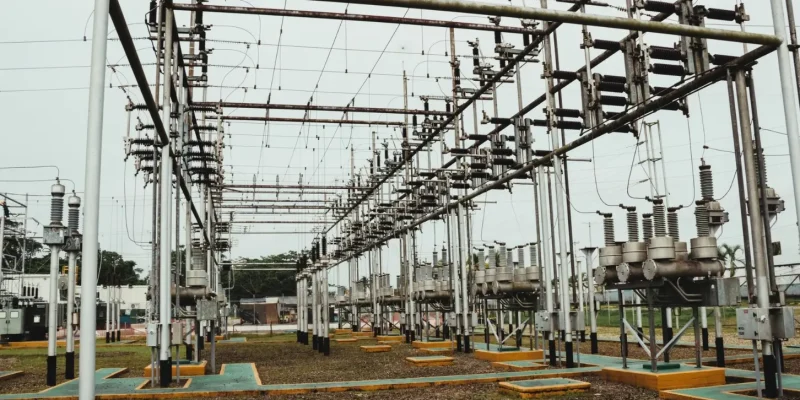Шинопровід - це важливий компонент систем розподілу електроенергії, що складається з металевої провідникової смуги або шини, яка слугує центральним вузлом для збору та розподілу електричної енергії. У поєднанні з автоматичними вимикачами шинопроводи утворюють надійну та безпечну мережу розподілу електроенергії, здатну захистити від електричних збоїв і полегшити обслуговування системи.
Функції та роль шин
Шинопроводи відіграють вирішальну роль у спрощенні складних розподілів електроенергії, роблячи їх більш доступними та гнучкими. Ці металеві провідники, зазвичай виготовлені з міді, латуні або алюмінію, слугують основою електричних систем, збираючи енергію від вхідних фідерів і розподіляючи її до вихідних ланцюгів. Велика площа поверхні дозволяє їм ефективно справлятися з великими струмовими навантаженнями, а їхня конструкція полегшує підключення та модифікацію розподільчої мережі. Централізуючи електричні з'єднання, шинопроводи спрощують організацію енергосистем, зменшуючи потребу в численних індивідуальних з'єднаннях і підвищуючи загальну надійність системи.
Переваги шинопроводів
Шинопроводи є важливими компонентами в сучасних електричних системах завдяки своїм унікальним перевагам над традиційними методами з'єднання. Вони забезпечують чудову ефективність розподілу електроенергії, мінімізуючи втрати енергії під час передачі завдяки низькому імпедансу та великій площі поперечного перерізу. Ця ефективність особливо важлива для сильнострумових систем, де навіть невеликі втрати можуть призвести до значних експлуатаційних витрат.
Оптимізація простору - ще одна ключова перевага шинопроводів. Вони зменшують потребу в численних кабелях і проводах, дозволяючи створювати більш компактні та організовані електричні установки. Ця функція економії простору особливо цінна в промислових умовах, центрах обробки даних та інших об'єктах, де простір має першочергове значення. Крім того, шинопроводи підвищують гнучкість і масштабованість системи, дозволяючи легко модифікувати або розширювати її відповідно до мінливих вимог до потужності. Довговічність, надійність і здатність витримувати високі температури та електричні навантаження роблять їх незамінними для забезпечення безпечної та ефективної роботи складних електричних систем.
Вибір матеріалу шинопроводу: Мідь проти алюмінію
При виборі матеріалу для шин основна увага приділяється міді та алюмінію, кожен з яких має свої переваги. Мідні шини мають кращу електропровідність, приблизно 58 МОм/м порівняно з 37 МОм/м алюмінію, що забезпечує вищу пропускну здатність і ефективність. Однак алюмінієві шини значно легші та економічно вигідніші, що робить їх привабливими для застосування в чутливих до ваги системах та проектах з обмеженим бюджетом.
Основні міркування при виборі матеріалу включають в себе наступні:
- Провідність: Мідь перевершує алюміній, вимагаючи менших шин для тієї ж потужності струму.
- Вага: Щільність алюмінію приблизно на третину менша за щільність міді, що дає переваги при транспортуванні та монтажі.
- Стійкість до корозії: Мідь від природи краще протистоїть корозії, тоді як алюміній може потребувати додаткової обробки поверхні.
- Теплове розширення: Алюміній має вищий коефіцієнт, що потенційно впливає на довготривалу стабільність у середовищах зі змінною температурою.
- Вартість: Алюміній, як правило, дешевший, хоча ціни коливаються залежно від ринкової кон'юнктури.
Вибір між мідними та алюмінієвими шинами в кінцевому рахунку залежить від конкретних вимог проекту, балансуючих факторів, таких як електричні характеристики, вагові обмеження, умови навколишнього середовища та бюджетні міркування.
Безпека монтажу шинопроводів
Правильний монтаж і дотримання протоколів безпеки мають вирішальне значення для забезпечення надійності та захисту шинопроводів. Під час монтажу шинопроводів важливо дотримуватися інструкцій виробника та галузевих стандартів, щоб запобігти ураженню електричним струмом і збоям у роботі системи. Основні міркування включають в себе наступні:
- Ізоляція: Шини повинні бути належним чином ізольовані, щоб запобігти витоку електроенергії та виникненню електричної дуги. Ізоляційний матеріал повинен витримувати робочу напругу і температуру системи.
- Захист від перевантаження: Встановіть запобіжники, автоматичні вимикачі або реле максимального струму для захисту від перевантаження. Ці пристрої мають бути підібрані відповідно до вимог системи.
- Маркування: Чітко маркуйте шини з відповідною напругою, фазою та полярністю, щоб запобігти плутанині під час монтажу та обслуговування.
- Опорні конструкції: Встановіть міцні опорні кронштейни, щоб витримати вагу шини та будь-які механічні навантаження. Забезпечте належну відстань між опорами, щоб зберегти цілісність конструкції.
- Засоби індивідуального захисту: Працівники повинні носити відповідні ЗІЗ, включаючи куртки з довгими рукавами, рукавички, захисне взуття та каски, під час роботи з шинопроводами та їх монтажу.
Регулярні перевірки та технічне обслуговування є життєво важливими для забезпечення безперервної безпечної роботи шинопроводів, включаючи очищення, перевірку ізоляції на наявність пошкоджень і заміну зношених компонентів.
Застосування шинопроводів
Шинопроводи знаходять широке застосування в різних галузях завдяки своїй ефективності в розподілі електроенергії. Вони широко використовуються в електричних розподільчих пристроях для високовольтного обладнання, акумуляторних батареях для низьковольтних систем і центрах обробки даних, де надійний розподіл електроенергії має вирішальне значення. Промислові об'єкти, такі як фабрики та заводи, значною мірою покладаються на шинопроводи за їх надійні можливості розподілу електроенергії. Крім того, ці металеві провідники відіграють життєво важливу роль у..:
- Енергетичні об'єкти
- Системи відновлюваної енергетики, включаючи сонячні та вітрові електростанції
- Комерційні будівлі та торгові центри
- Телекомунікаційна інфраструктура
- Транспортні вузли, такі як аеропорти та залізничні вокзали
Універсальність і масштабованість шинопроводів роблять їх ідеальним вибором для проектів від невеликих житлових будинків до великих промислових комплексів, забезпечуючи ефективний і безпечний розподіл електроенергії в різних середовищах.
Таблиця розмірів шин MCB
Розміри шин MCB варіюються залежно від пропускної здатності, необхідної для електричної системи. Стандартні розміри шин зазвичай варіюються від 20×6 мм до 100×10 мм. Нижче наведено короткий огляд поширених розмірів шин і відповідних їм потужностей струму:
- 20×6 мм і 20×10 мм: Підходить для застосування з меншим струмом
- 30×10 мм і 40×10 мм: Шини середньої потужності
- 63×10 мм, 80×10 мм і 100×10 мм: шини більшої ємності
Для більш потужних застосувань розміри шин можуть збільшуватися до:
- 630, 800, 1000, 1250, 1600, 2000, 2500, 3200, 4000, 5000 і 6300 ампер
Вибираючи розмір шинопроводу, враховуйте такі фактори, як необхідна потужність, температура навколишнього середовища та матеріал (мідь або алюміній). Для точного визначення розміру зверніться до таблиць потужності, наданих виробником, або скористайтеся калькулятором розмірів шин, який враховує конкретні умови монтажу та фактори безпеки..
Комерційне та житлове застосування
Шинопроводи відіграють важливу роль як у комерційних будівлях, так і в домогосподарствах, пропонуючи ефективні рішення для розподілу електроенергії, пристосовані до різних масштабів електричних потреб. У комерційних приміщеннях шинопроводи широко використовуються для управління потужними навантаженнями на різних поверхах і площах, спрощуючи складні системи електропроводки і забезпечуючи стабільне електропостачання в усій будівлі. Вони особливо цінні в офісних комплексах, торгових центрах і великих житлових будинках, де необхідний централізований розподіл електроенергії.
Шинопроводи для домогосподарств, хоча і менш поширені, знаходять все більше застосування в сучасних електричних системах. Вони використовуються в домашніх розподільчих панелях, акумуляторних батареях і зарядних станціях для електромобілів (EV), де ефективність використання простору і безпека мають першорядне значення. Як в комерційних, так і в побутових системах шинопроводи мають ряд переваг:
- Підвищена надійність і зменшені втрати потужності завдяки низькоомній конструкції
- Підвищена безпека завдяки мінімізації складної проводки та потенційних точок перегріву
- Ефективність використання простору, особливо корисна в міському середовищі з обмеженим простором
- Простіше розширення та обслуговування системи, що дозволяє в майбутньому модернізувати її без значного перепрофілювання проводки
- Економічна ефективність у довгостроковій перспективі, незважаючи на потенційно вищі початкові витрати, завдяки зменшенню витрат на технічне обслуговування та підвищенню ефективності
Висновок
Шинопроводи - це неоспівані герої комерційного розподілу електроенергії, які забезпечують безпечні, ефективні та гнучкі рішення для розподілу електроенергії у великих будівлях. Хоча вони можуть бути приховані за панелями та в електрощитових, їхня роль у забезпеченні наших комерційних приміщень електроенергією неоціненна. Пам'ятайте: Всі роботи з електромонтажу та технічного обслуговування повинні виконуватися кваліфікованими фахівцями. Складність і сильний струм шинопроводів роблять професійні знання необхідними для забезпечення безпеки та надійності.


